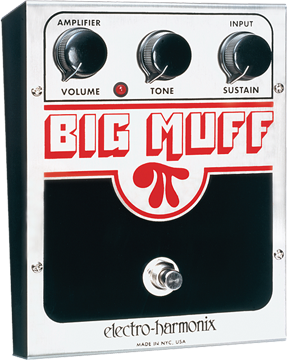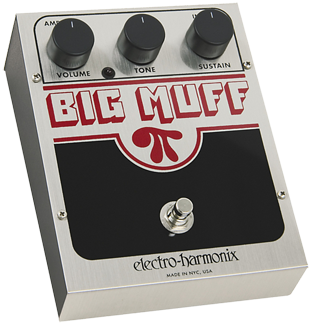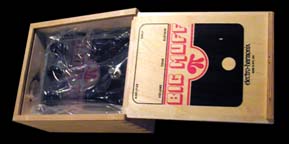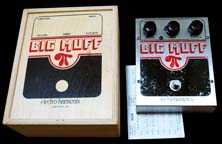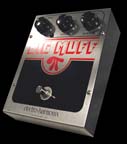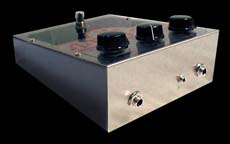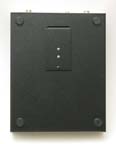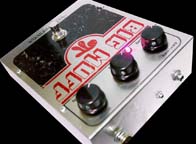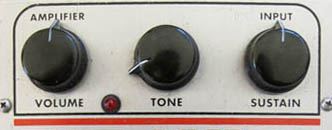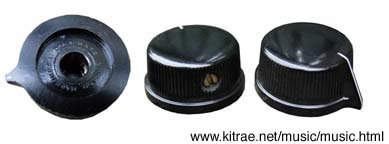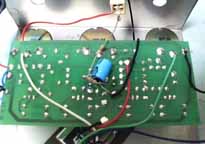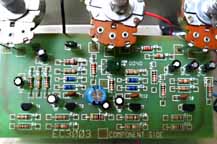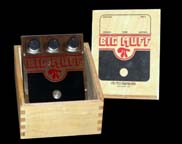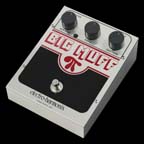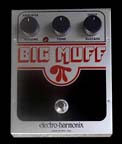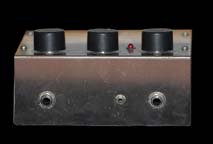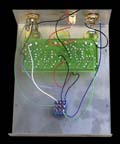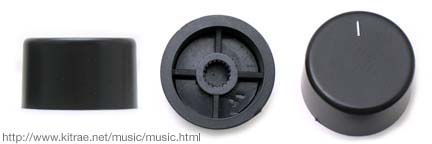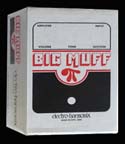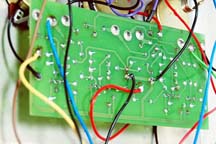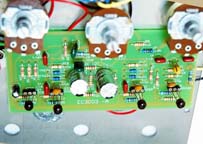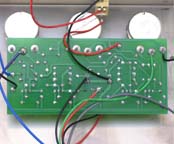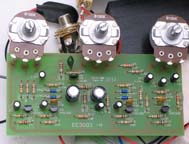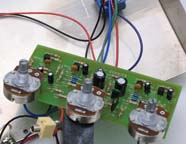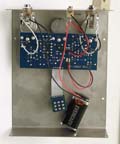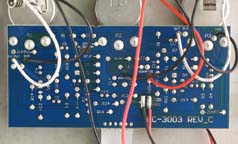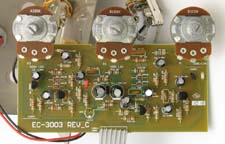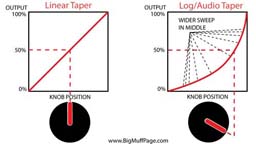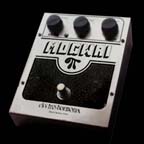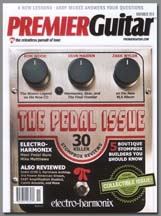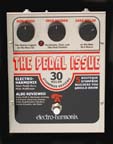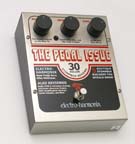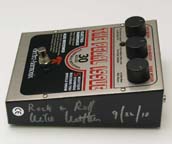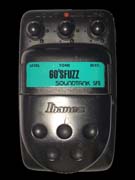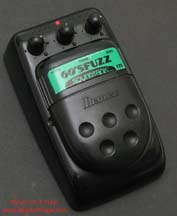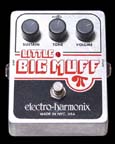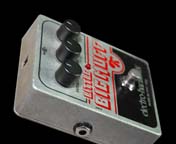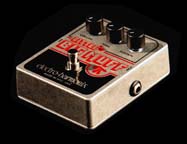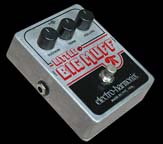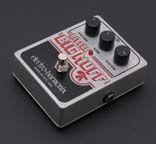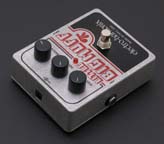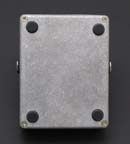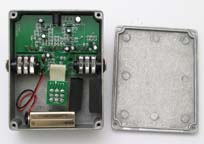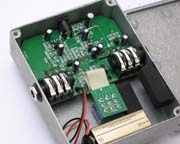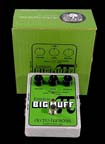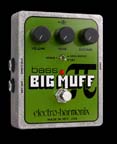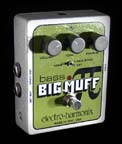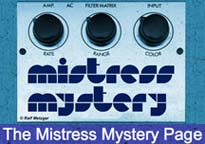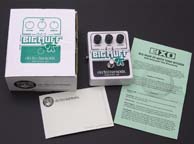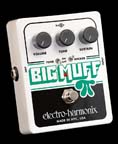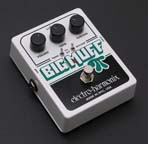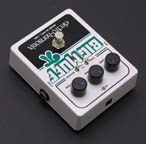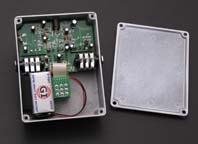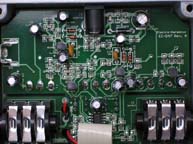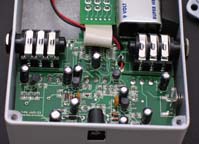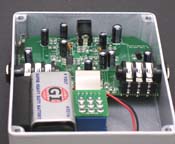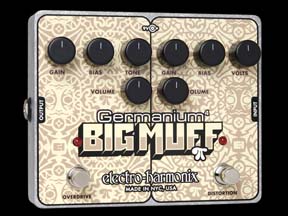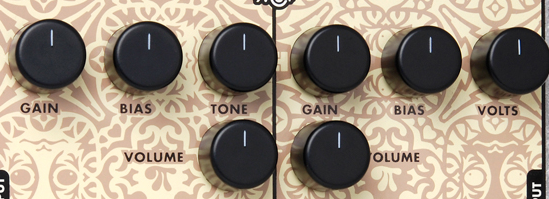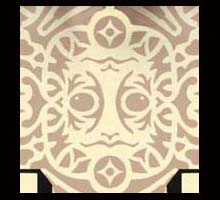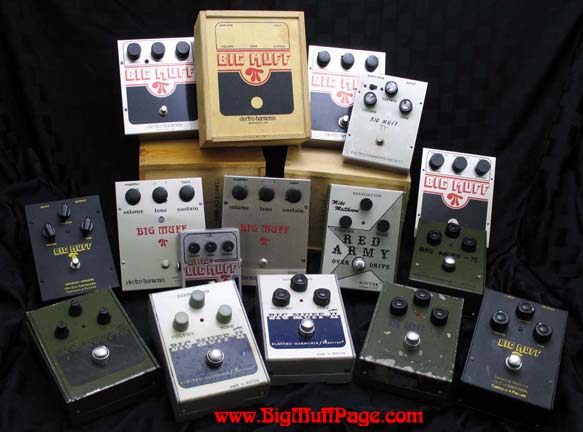THE BIG MUFF π - A HISTORY OF ALL VERSIONS - Part 3
Click on any Big Muff in the image below to go directly to that section
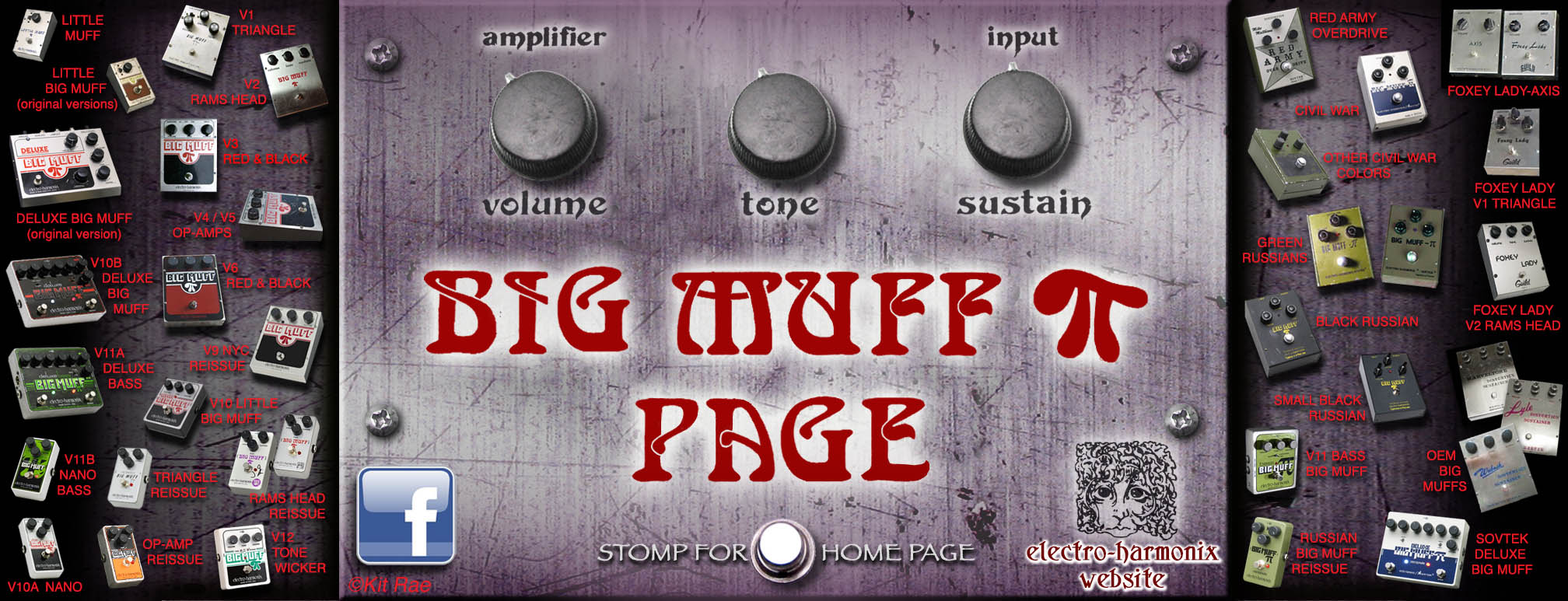
VERSIONS 9 - 12 (2013 - Present)
Last update March 2017. NOTE: This website is constantly updated as new information becomes available. Version, Edition, and Revision numbers listed here are not actual Electro-Harmonix identifiers. They are my categorizations, for identification purposes only. Permission required to repost any information from this site in any ebay listing. Website and contents ©Kit Rae
THE NYC CLASSIC BIG MUFF π - VERSION 9
2000 to present
Designer: Original circuit design by Bob Myer. V9 circuit modifications by E-H engineer Fran Blanche
Circuit Variants: 6
Model Numbers: EC3003 (2000), EC3003A (2000), EC3003B (2007), EC3003C (2008), EC3003D (?), EC3003E (2013)
True Bypass: Early production was not true bypass, but after 2001 all USA Big Muffs were made true bypass
Power: Current draw approximately 3 mA. 9V battery or power jack for an AC adaptor. Jack is 1/8" (3.5mm) plug tip positive. This is reverse polarity of typical pedals so use an E-H power supply or use a converter adaptor like the 1 Spot C35 3.5mm Converter
Place of Manufacture:Not specified. EHX uses parts sourced both domestically and foreign. Assembled and tested in Long Island City, New York, USA
Packaging: Wood box with red and black printing. Later production changed to a white corrugated cardboard box with same printing
Your piece of the pi. Nicknamed the Classic NYC (New York City) Big Muff Pi. Early on it was referred to as the 'NYC Reissue Big Muff Pi', even though technically it was not a reissue of any previous version. Since the 1991 return to production of the Big Muff manufactured in Russia, E-H founder/owner Mike Matthews found that there was also a demand for the return of a USA Big Muff. EHX began working on the reissue in the Astor Place facility in Manhattan, New York. Fran Blanche, superb boutique pedal maker and founder of Frantone, was given the job revising the circuit for the reissue. She worked for EHX from January 1999 to the Summer of 2000 and was responsible, along with J.C. Morrison, for the design of the huge EHX tube burning and testing machines.
Fran spent a few months building prototypes of variations on the classic Big Muff circuit design, as well as some new versions of the circuit. Mike Matthews and several other E-H employees reviewed and tested these dozen or so different prototypes. One of the classic version prototypes was chosen to be the new USA Big Muff. The circuit architecture is essentially the same as the original Bob Myers BMP design, only with a new set of component values. This was nothing new in the history of the Big Muff, as there were literally dozens of different variants of the circuit made throughout the 1970s. It was continually revised. In 2000 the Big Muff returned to production once again in New York, now in Matthews' Long Island City facility (thanks to Fran Blanche for additional info).
GRAPHICS AND ENCLOSURE - Version 9 used the same style folded sheet metal box and graphics as the older USA version 3-6 Big Muffs. The silk screened graphics were identical to the version 3-6 graphics with the ITC Poneer Big Muff font, but the words TONE BYPASS were removed since there is now no tone bypass switch, and (annoyingly) no on/off switch. I have seen a few V9's varinats without the large black graphic on the lower half, so the satin steel enclosure shows there, like some V6 Big Muffs. A red LED light was added to the upper left of the box top, and a door cover was added to the back of the box to access the 9v battery - both firsts for a USA Big Muff. All previous Muffs required the entire top of the enclosure to be removed to access the battery. The AC adaptor jack remained from previous versions, although it is positioned slightly farther away from the AMPLIFIER jack than on versions 3-6. There were four rubber feet on the bottom as on the V3-6 Muffs.
THE MOGWAI "ROCK ACTION" BIG MUFF - This was a custom silk screened version of the stock 2001 Big Muff used to promote the release of Scottish band Mogwai's third album, Rock Action. More information about this rare OEM version can be found here.
THE "PEDAL ISSUE" BIG MUFF - In 2010 Premier Guitar magazine ran a special pedal issue that featured four different covers, each showcasing an effects pedal with custom graphics incorporating the magaizine content graphic design. Naturally the Big Muff was chosen as one of these pedal issue covers. Working with Rick Stevenson at EHX, Premier designed the initial graphics and EHX graphic artist Lisa De Santis revised with the correct Big Muff font and colors, and added the Pi logo (which was almost left off). Jorge Martinez, EHX silk screen artist, applied the graphics to the pedal. The circuit inside was the current revision C version. Only a small number of these were made for the issue cover, and as a contest givaway by Premier Guitar (thanks to Rick Stevenson and Larry Demarco of EHX for additional info, and Mike Matthews for donating one to the Big Muff Pi Page).
CONTROLS / KNOBS - Early production V9 Big Muffs were made with the old style Daka-Ware pointer knobs with ridged sides until around 2001. These knobs were made by Davies Molding of Chicago and are almost identical to their old Daka-Ware V2/V3 Big Muff knobs used in the 1970s, with the exception of an added white indicator line. E-H continued to use these knobs in their advertising up to the late 2000s even though they stopped shipping product with them around 2001 and changed to similar flat topped "hockey puck" shaped knobs as used on the V5 and V6, and other E-H pedals. These new puck knobs were slightly smaller than the vintage Daka-Ware knobs.
CIRCUIT - In 2000 the first edition circuit board was marked EC3003 and used four 2N5088 transistors. Tone sucking when in bypass mode was a common complaint about EHX pedals, and the "true bypass" fad was beginning around this time, so a true bypass foot switch was added with the EC3003-A revised circuit board later that year. The component values appear to be a mix of a late 1970s V2 BMP, with a deeply mid-scooped tone section from one of the early V1 BMPs, and 390Ω emitter resistors in the clipping stages from a Sovtek BMP. The 3003-A revision from 2001 was basically the same. Previous USA Big Muffs used 1N4148 Silicon diodes, but EHX changed to 1N6263 Silicon Schottky diodes for the reissue in 2000. EHX changed back to 1N4148 diodes around 2008. 1N4148 compress the sound a bit more more, giving a sharper sound but with slightly less treble than 1N6263, partly contributing to the different sound of the reissues.
In 2007 the board was changed to a third edition EC3003-B schematic with BC550C transistors. In 2008 it was changed to a fourth edition EC3003-C schematic, also with BC550C transistors. The EC3003-C revision changed the volume pot to a 500k logarithmic taper pot, though the tone and sustain pots remained 100k linear taper as on previous Big Muffs. There were also 3003-D and 3003-E circuit revision between 2008 and 2013. Most of these revisions did not affect the sound much, but there is a big difference between the original 2000 circuit and the version from 2007 and later.
PACKAGING - These originally shipped in a wood crate but later changed to a 3-color corrugated cardboard box that matched the style of the old V3-6 Muff boxes, presumably to reduce the manufacturing cost. "Your piece of the pi" was printed in the inside box lid flap.
These V9 NYC reissues are often confused with the vintage black and red Big Muffs made from the late 1970s through 1980s, but the vintage versions did not have an LED light and included the slider switch on the back. Some of the re-issues were made with the old style pointer knobs with ridged sides, almost identical to the old V3 knobs, which has added to the confusion. The easiest way to tell if it is a V9 reissue is to look for the red LED on the front and the battery door cover on the back. That LED changed from a standard red LED to a clear red LED around 2008.
THE SOUND - The tone is in the same family as the old version 6 Big Muffs from the early 1980s, though this is not actually a reissue of that version. Component values were changed, making it a bit more muffled (muffier?), and modern sounding, without the clarity of most of the early vintage USA Muffs. The first version is the most like the old early 70's Big Muffs, with a bit more note clarity than the later revisions, and slightly less bass. The 2000 and revision A circuits sound the same. The component values were modified in 2007 (revision B) and then again in 2008 (revision C). The later versions have a thicker and bassier sound than the Rev A and B circuits, with less note clarity, but a thicker and heavier sound when playing chords. The bottom end is also beefier on the B and C versions than most vintage Muffs. Presumably this was done to give them a more modern, heavy and dronier sound. Mid tones are very scooped. These do not react as sharply to pinch harmonics as the V1, V2, and V3 Big Muffs and do not work as well for crisp palm muting as some early Muffs. It has a grungier, but very cool character to the sound. Think Jack White of the White Stripes' tone. The bass and treble varies slightly from unit to unit, but the differences are usually minor.
Sound Clip 1 - Wet solo lead tone in normal mode. Strat into Fender Twin.
Shown above - The V9 NYC Reissue Big Muff with old V3 Daka-Ware style knobs, made in 2000. Note the new battery door cover, not found on any vintage USA Big Muff.
Shown above - V9 Reissue Big Muff knobs. Note the white paint idicator line on the knob pointers, only seen on the resissue and not on any vintage Muffs. These knobs (set screw version shown), made by Davies Molding of Chicago, were used until around late 2001
Shown above - A first edition EC3003 circuit board from the V9 Reissue made in 2000 (thanks to Liberty Belle for the photos)
Shown above - The V9 NYC Reissue Big Muff with EC3003-A circuit board and "hockey puck"style knobs used from 2002 to present. These shipped in a wood box similar to the Russian made Sovtek Big Muffs. Note the blue true bypass switch, added for the Rev A.
Shown above - Around 2005 the V9 NYC Reissue Big Muff wood box was changed back to a cardboard box with pedal graphics like the vintage mid to late 1970s USA Big Muffs
Shown above - Two V9 Reissue EC3003 A circuit boards.
Shown above - V9 Reissue EC-3003 REV C circuit boards. Note the 500k log/audio taper volume pot that replaced the standard 100k linear taper pot on all previous USA Big Muffs
Shown above - The Mogwai "ROCK ACTION" Big Muff. A custom silk screened version of the 2001 Big Muff used to promote the release of Scottish band Mogwai's third album, Rock Action, which replaced TONE SUSTAIN in the graphics with ROCK ACTION. More information on this version can be found here. Contrary to popular belief, the circuit was just the stock 2001 BMP circuit, not a special modified version.
Shown above - The "Pedal Issue" Big Muff with custom graphics created for the cover of the Premier Guitar November 2010 pedal issue. "Rock & Roll" and autograph by Mike Matthews. This is one a of a very small number made
THE IBANEZ SOUNDTANK BIG MUFF CLONES
View the page about the Taiwan made Ibanez version of the Big Muff circuit, the 60's Fuzz, circa 1999.
1995 - 2000's - THE ERA OF BIG MUFF MODS and BOUTIQUE BIG MUFF CLONES
In the mid 1990's the Big Muff circuit modifications that are common today were only just starting to be discussed worldwide on a few internet forums and chat rooms. Pete Cornish was one of the first people known (though unkown to the public at the time) to have been making modified versions of the Big Muff circuit, going as far back as the late 1970's with the first custom Big Muff pedal for David Gilmour of Pink Floyd, then with his P-2 and G-2 variations in the 1990's. Jeorge Tripps (who would later work with Dunlop) was one of the first to make a BMP clone with a modified tone section in 1995, the Swollen Pickle, also offering a mids switch option. Ron Neeley of Ronsound started offering mods to Big Muffs in the late 1990's. In 1999 Jack Orman (muzique.com) published his A Close Look at the Big Muff & Proco Rat e-book, featuring an in-depth examination of the circuit and several mods. The first highly successful modified BMP clone hit the market in 1999, the Sustain Punch Creamy Dreamer. In 2001 Jack Orman posted his Muff Boost project online, and in 2002 the Muffmaster, both decent booster stages to place in front of the BMP. Jack also posted his AMZ tone/presence control mod in 2002, one of the best tone section mods for the Big Muff. In 2003 Aron Nelson summarized several mods that apply to the BMP circuit on his Simple, Easy Mods/Tips & Techniques page from DIY Stompboxes, including the idea to change the diodes to LED's, among the many other useful mods.
Ron Neeley (The EH Man) of Ronsound started making his own Big Muff clone called the Hairpie in 2003, later adding a mids switch. Marc Ahlfs of Skreddy pedals began making very popular modified Big Muff clones in 2004, later including a mids switch as a standard feature. Across 2004 and 2005 more and more boutique, hand made BMP's started to appear - Jamie Stillman of Earthquaker Devices created the Hoof pedal, Baja Tech made the Da Moaf, MJM made the Foxey Fuzz, Euthymia made the ICBM, Dice Works made the Muff Diver, and D.A.M. made the Ram Head, among others. In 2005 the Piso-Tones website posted the first collection of Big Muff circuit variant schematics. In 2006 Berarduur (from the old Geekchat website) compiled a great selection of Big Muff specific mods, the Big Muff Pi Mods and Tweaks page, which has become sort of the bible of BMP mods. B.Y.O.C. (Build Your Own Clone) also released the Large Beaver kit in 2006, which was a very versatile, build-it-yourself vintage Big Muff with an adustable tone selector mod. A whole host of new boutique BMP clones continued to appear on the market after this, utilizing these mods or variations of them, many detailed below.
While the reborn Electro-Harmonix company continued to expand and innovate their range of USA Big Muff pedals in the 2000's, dozens and dozens of different BMP clones were being made by dozens of small boutique makers. Many were straight up replicas of vintage BMP circuits, like the superb range offered by Stomp Under Foot, and many were customized variations of the circuit, like those created by Skreddy Pedals. Even the large corporate companies got back into making versions of the BMP, like the Behringer Vintage Distortion and Dunlop Swollen Pickle.
THE LITTLE BIG MUFF π “XO” - VERSION 10
2006 to present
Edition Versions: 2 - Control knob position changed for second edition
PCB Numbers: EC-D1, EC-D2, EC-D2 Revs A - E, EC-D3
Circuit Variants: 4
True Bypass: Yes
Power: Current draw 4 mA. 9V battery or AC (9.6vdc/200mA) power jack with negative tip polarity. Uses standard Boss type adaptors.
Packaging: Corrugated cardboard box
Place of Manufacture:Not specified. EHX uses parts sourced both domestically and foreign. Assembled and tested in Long Island City, New York, USA
Your little slice of the pi. A small box version of the Big Muff that fits much more easily onto a cramped pedal board. Produced in early 2006, this was part of the new XO line of smaller sized E-H effects. Despite the name, this is not a reissue of the original, one knob, Little Big Muff from the 1970s. It is a compact version of the V9 full size Big Muff, though the circuit is not exactly the same, and the sound is slightly different. Here is what EHX said about it in their advertisements:
After extensive research into what made the 1970 Big Muff such a special and legendary pedal, Electro-Harmonix came up with a new addition to its Big Muff family: The Little Big Muff. Housed in a compact, die-cast box with smooth corners, The Little Big Muff presents the classic, true-to-heritage, 1970 tone that falls somewhere between the current U.S. Big Muff and the Russian Big Muff. Its long, silky smooth sustain proves that celebrated sound can indeed come in small packages. With a familiar control layout and a pedigree you can trust, this little brother kicks total butt.
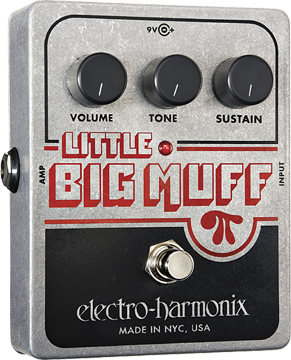
CONTROLS / KNOBS - Standard three Big Muff controls - volume, tone, and sustain. The first edition of the XO Muff was made with the volume and sustain knobs in the reverse position to the later edition, and the first edition had more volume to the pot than the second. The control knobs are black plastic, a mini version off the hockey puck shaped knobs used on the full size Big Muff.
ENCLOSURE AND GRAPHICS - Housed in the standard EHX X-O sized cast metal enclosure, 4 3/4" (L) x 4 " (W) x 2 3/16 "(H). Tumbled cast aluminum surface finish. Graphics follow the style and colors of the V3-6 Big Muffs with the ITC Pioneer Big Muff font. Four screws on the bottom plate and four rubber pads. Plate must be removed to change the battery. A red LED light shows when the circuit is on.
CIRCUIT - This is basically the same schematic as the large box V9 reissue Big Muff, though several component values are different. The old large through-hole components were replaced with the newer micro sized SMD, or "surface mounted" components. Transistors in mine are unmarked, but these are probably BC550s, or 2N5088/MMBT5962 as the various schematics call for. The circuit is true bypass. It runs off of either a 9V battery or an industry standard 9V AC adaptor. For the first time, the AC polarity of a Big Muff was changed to standard polarity. All previous USA Muffs were reverse polarity. This meant you could use a standard Boss type AC adaptor to power it.
PACKAGING - 2-color corrugated cardboard box. "Your little slice of the pi" is printed on the inside box lid flap.
THE SOUND - Sonically the Little Big Muff sounds very similar to the NYC reissue V9 described above, but a bit brighter and a bit less bottom end to the sound. Note, this is not a reissue of the original 1970s Little Big Muffs. Some units sound slightly different than others.
Sound Clip 1 - Wet solo lead tone in normal mode. Strat into Fender Twin.
Shown above - Early V10 “XO” Little Big Muff with "SUSTAIN" and "VOLUME" knobs in reverse positions, circuit dated 2005
Shown above - Second edition Little Big Muff with knobs switched back to normal positions, and the EC-D2 rE circuit board with SMD micro components
THE USA “BASS” BIG MUFF π - VERSION 11
2008 to present
Designer: John Pisani, E-H senior engineer (based on the original Bob Myer circuit)
PCB Numbers: EC-D40, EC-D40 Rev A
Circuit Variants: 2
True Bypass: Yes
Power: Current draw 7 mA. 9V battery or AC (9.6vdc/200mA) power jack with negative tip polarity. Uses standard Boss type adaptors.
Packaging: Corrugated cardboard box
Place of Manufacture: Not specified. EHX uses parts sourced both domestically and foreign. Assembled and tested in Long Island City, New York, USA
Your deep dish pi. The Bass Big Muff was added to the EHX "XO" line in 2008. The literature from EHX states that the BBM was based on the legendary green Russian Big Muffs and the original 1970s Big Muffs. It works very well with guitar or bass and is very similar to the Russian made Sovtek Big Muff sound, with some added tone controls. For years bass players had been using Russian made Sovtek Big Muffs because of their huge bottom end and low gain distortion that handles bass frequencies well. The BBM was created to fill the void when the Sovtek Big Muff was discontinued. E-H senior engineer John Pisani, created this version, which includes few bass guitar specific features.
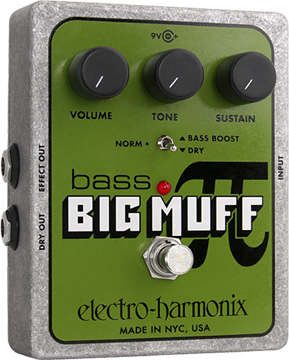
DEVELOPMENT - John Pisani started with Electro-Harmonix in April of 2000. He has worked on various pedals as senior engineer, including the Holy Grail, Memory Boy, Memory Toy, Deluxe Memory Boy and 22 Caliber. The BBM was his first Big Muff engineering project, taking approximately eight months to develop and test. Here are John's recollections about the BBM development:
"We were very aware that many musicians used the Big Muff Pi on bass, especially the Russian Muffs. The direction we decided to take was to find out what bass players thought of the Big Muff, why was it good and what were its deficiencies when used with bass. After identifying some common problems with a Big Muff on bass and also knowing what people liked we went to work on creating the bass version. The first step was to find a great sounding Russian Muff, we used a black one (Editor's note - the circuit of the Black Russian Muff is almost idetical to the green Russian Muff that the E-H literature states this is based on, with just a few component changes). Once we had the Russian Big Muff the majority of the work spent on the BBM was to make a couple prototypes sound and work just like the Russian model. The idea behind the prototypes was, can make a mass manufacturable Big Muff sound like a Russian one, using components that are readily available to us.
We took a Little Big Muff board and used it as a prototype board for the Bass Big Muff. The advantage to using the Little Big Muff as a starting place, knowing the BBM would go in the same sized enclosure, was that we could prove we could make the Little Big Muff sound like a Russian Muff. Of course by the time it was sounding like a Russian Muff it was nowhere near the same pedal as the Little Big Muff we started with. This prototype BBM had numerous switches and controls on it so that we could ask people if they preferred one tone stack over another, one kind of bass boost over another or a dry volume preference. We ended up tweaking the tone stack a little bit so it is not exactly the same tone stack as in a Russian Big Muff but we also think the tone stack works better for bass than the stock Russian tone stack. There were a few different versions of the bass boost circuit as well.
I would not consider myself a bass player though I own a couple basses and have played bass in at least one band when I was younger. I have also recorded bass lines on my own songs. We have a couple bass players that work at EHX so they provided much of the feedback as the Bass Big Muff was being developed. We probably went through close to 10 bass boost circuits before deciding on the one that would be part of the production circuit. 95% of the testing was done with bass and bass amps. It was designed strictly for bass players. It's nice to hear guitar players like it too though. It seems like many people like to mix their dry signal in with the distortion."
ENCLOSURE AND GRAPHICS - Housed in the standard EHX X-O sized cast metal enclosure, 4 3/4" (L) x 4 " (W) x 2 3/16 "(H). Tumbled cast aluminum surface finish. Same ITC Pioneer Big Muff font as on previous USA MUffs. The green color is intentionally reminiscent of the old green Russian Big Muffs. Four screws on the bottom plate and four rubber pads. Plate must be removed to change the battery. A red LED light shows when the circuit is on.
CONTROLS / KNOBS - Standard three Big Muff controls - volume, tone, and sustain. The frequencies of the tone sweep are slightly different than the Russian Big Muff since this was tailored for a bass. It includes a three position toggle switch - BASS BOOST, NORM, and DRY. Dry mixes your dry signal with the BBM's distortion. When the BBM is set to DRY the volume pot sets the volume of the distortion signal but has no effect on the volume of the DRY signal, which remains at unity gain at all times. Bass boost is like it sounds - boosts the bass frequency. Normal setting is similar to a stock Black Russian Big Muff. The control knobs are the small black plastic hockey puck type, the same used on the Little Big Muff and Bass Big Muff.
CIRCUIT - Based on the Russian Big Muff and 1970s Big Muff circuits. Circuit board is populated with micro sized SMD, or "surface mounted" components. Transistors are BC547C, same as the last black Russian Big Muffs. The circuit is true bypass. Includes both direct (effect on) and dry output (true bypass) jacks.
PACKAGING - 2-color corrugated cardboard box. "Your deep dish pi" is printed on the inside box lid flap.
THE SOUND - The Bass Big Muff is in the Sovtek tone family, in that it has a heavy, fat, but smooth disortion. Slightly less gain than the classic Big Muffs, Little Big Muff, and Nano Big Muff, and as a result, less noisy. Although it is called a Bass Big Muff, is a normal Big Muff circuit as you would use for guitar. The reason it is called the Bass Big Muff is that many bass players liked to use the old Sovtek Big Muffs, and EHX also wanted to differentiate this more bassy sounding Big Muff from the standard models. All toggle switch settings - bass boost, norm, and dry - sound very good with either bass guitar or standard guitar. For guitar, the normal setting is very close to the black Russian Big Muff tone (V8).
Sound Clip 1 - Wet solo lead tone in normal mode. Strat into Fender Twin.
Sound Clip 2 - Wet solo lead tone with bass boost switch on. Strat into Fender Twin.
BBM vs. V8 Black Russian Big Muff - chords. Russian first, then BBM
BBM vs. V8 Black Russian Big Muff - leads. Russian first, then BBM
BBM vs. V8 Black Russian Big Muff - guitar volume at half. Russian first, then BBM
Shown above - The Bass Big Muff. "Your deep dish pie", as Electro-Harmonix stated on the packaging. Based on the black Russian Big Muff with some added tone selection. The green graphics were probably intended to relate this to the old green Russian Muffs
THE USA “TONE WICKER” BIG MUFF π - VERSION 12
2009 to present
Designer: E-H junior engineer David Tuzman, supervised by EH senior engineer John Pisani (based on the original Bob Myer circuit)
Edition Versions: 1
PCB Numbers: EC-D47, EC-D47 Rev A
Circuit Variants: 2
True Bypass: Yes
Power: Current draw 5 mA. 9V battery or AC (9.6vdc/200mA) power jack with negative tip polarity. Uses standard Boss type adaptors.
Packaging: Corrugated cardboard box
Place of Manufacture: Not specified. EHX uses parts sourced both domestically and foreign. Assembled and tested in Long Island City, New York, USA
Your pi with the works. The USA made Little Big Muff circuit was re-worked with some added features in 2009. Here is what Electo-Harmonix founder and owner Mike Matthews had to say about this version:
"I wanted to hear again what the Big Muff sounded like if I hadn’t inserted those 3 roll off capacitors (Mike added these to Bob Myer's original Big Muff circuit design in 1969 to smooth out the raspiness), so we put in a switch so that the user could have the option of taking them all out or leaving the Big Muff the way it was. This time, the raspiness option sounded good to me, and it helped a lot to open up natural feedback between guitar and amp. Then I tried a second thing, We put in a switch to completely take out the strong tone control of the Big Muff (the same feature as on the old V5 and V6 tone bypass Big Muffs). This gave a really wide sound."
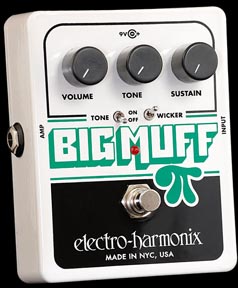
ENCLOSURE AND GRAPHICS - Housed in the standard EHX X-O sized cast metal enclosure, 4 3/4" (L) x 4 " (W) x 2 3/16 "(H). The box is the same as the Little Big Muff but with a white/green/black color scheme. Same ITC Pioneer Big Muff font as previous Muffs. Cast metal two piece box with four screws on the bottom plate and four rubber pads. A red LED light shows when the circuit is on.
CONTROLS / KNOBS - Same three controls as the V10 Little Big Muff, but with a new Tone-Bypass toggle switch and Wicker toggle switch. The Tone Bypass completely bypasses the tone control, similar to the TONE-BYPASS Big Muffs of the late 1970s/early 80s. The tone knob has no effect when engaged. The new “Wicker” toggle switch bypasses the roll-off filter capacitors in the first three stages of the circuit, adding a top end boost to the sound. This was one of the biggest changes ever made to the Big Muff sound. The control knobs are the small black plastic hockey puck type, the same used on the Little Big Muff and Bass Big Muff.
CIRCUIT - It is built with normal through-hole style transistors, capacitors, and diodes. Resistors are small surface mount style. The circuit is a different design than the V10 Little Big Muff. The transistors are four BC550Cs. Early circuit boards are marked EC-D47, and later EC-D47 Rev. A. It runs off of either a 9V battery or an industry standard 9V AC adaptor.
PACKAGING - 2-color corrugated cardboard box. "Your pi with the works" is printed on the inside box lid flap.
THE SOUND - The tone range of the V12 Big Muff is quite broad. It can match the tones of the V10 Little Big Muff somewhat in standard mode, but with the Wicker switched on it becomes a much sharper and brighter sound, but not too harsh. The "buzzy-fizzy" sound that many Big Muff users complain about with the V9 NYC reissue and V10 Big Muffs can be smoothed out with the Tone Wicker. The "fuzz" tones it produces have much more range than the V9 and V10. Many Muff users (like me) use boosters or tube drivers to color or boost the gain and mids of their Big Muffs for added clarity, but this version does not require that. The boost is built in, and it cuts through a band mix very well. Compared to vintage USA Big Muffs, this sounds very different, but this is one of my favorites of the Muffs produced since 2000. Some units sound slightly different than others.
Sound Clip 1 - Wet solo lead tone in normal mode. Strat into Fender Twin.
Shown above - A 2009 Big Muff Tone Wicker and circuit with micro SMD components
Released July 2010
Designers: Bob Myer and Daniel Shin
Edition Versions: 1
PCB Numbers: NA
Circuit Variants: NA
True Bypass: Yes
Power: The current draw is 12mA. 9V battery or AC power jack. The optional 9V power supply from Electro-Harmonix is 9.6DC-200BI (same as used by Boss™ & Ibanez™) 9.6 Volts DC 200mA.
Packaging: Corrugated cardboard box
Place of Manufacture: Not specified. EHX uses parts sourced both domestically and foreign. Assembled and tested in Long Island City, New York, USA
Your germanium stuffed pi. In 2010 a new addition to the Big Muff line was announced, a versatile combo pedal that includes both Overdrive and Distortion sections, each based around warm Germanium tones. These are more overdrive-distortion-fuzz circuits rather than super clipped and mids scooped Big Muff type circuits. In the past I have stated that this website was strictly for true Big Muff pedals, based on the original four stage Big Muff circuit with its distinct sound. Over the years, and at readers requests, the website has grown to include most of the other Muff versions as part of the overall history, and I have grown very fond of those other pedals, so I have decided to include this version as well. Plus, the lead designer for this version is Bob Myer, the man who designed the very first Big Muff back in 1969! Since the first pedal in the Muff lineage was the Muff Fuzz, it brings it all around full circle to the beginning with the G4BM.
THE DESIGN - In 2009 Mike Matthews asked Bob Myer to design a new transistor amplifier with controls on the parameters of the device to allow Mike and his staff to test different operating conditions and determine which ones produced the most desireable results. It was Mike Matthews idea to use Germanium transistors rather than the more commonly used Silicon type, as he wanted to capture the essence and tone of the Germanium sound, rather than the traditional Big Muff silicon sound. Germainum goes back a long way, as they were the transistors used in the very first fuzz pedals created in the 1960s. Ge transistors have never been easy to manufacture consistantly, and when more reliable Silicon transistors came along in the 1970s they all but wiped out the Ge transistor market. Based on Mike's ideas, Bob came up with two different circuit designs with variable control parameters, each including two Germanium transistors as the basis for the sound. These were then passed on to EXH designer Daniel Shin.
Daniel had worked at EHX for 2 years as an engineer, delving in different aspects of product development, including design, circuit design, and mechanical design. A few of the many projects Daniel has been involved with are the EHX Enigma/Riddle pedal, the VoiceBox, the V256, and the 44 magnum amp. Bob had presented EHX with several designs, prototypes and ideas, and it was Daniel that surveyed each of these. There were a lot of options to the circuit, and Daniel spent a lot of time getting people to listen to different aspects of the sounds it could produce, and deciding what to keep for the final pedal. Being a guitarist himself, Daniel was one of the group of testors, along with senior engineer John Pisani, Mike Matthews, and some of the EHX sales staff. Ultimately they really liked the way the two circuits sounded. It was decided that the pedal should include both, along with all the adjustable parameters, and the Germanium 4 Big Muff was born. After deciding what the product would actually be, Daniel worked with Bob Myer in order to update parts of the circuit so that it would perform exactly as they wanted, then he created the PCB design and worked out the product engineering aspects of the pedal.
"The G4BM definitely has its own sound. But with the adjustability of the circuit, you can get a wide variety of tones, including more vintage fuzz tones, OD tones, as well as raunchy distortion. It doesn’t have that great saturation as the Big Muff though, as we were aiming for more of a Distortion/Over Drive type of thing...What we came up with was a pedal that captures the warmth of the germanium sound and is capable of going from completely clean, to warm and smooth, to insane and over the top." - EXH designer Daniel Shin
I asked Daniel what he thought about the original Big Muffs, and how it felt to be working on a new addition to this legendary line of pedals.
"I love Big Muffs. I listen to a lot of Big Muff working here, and I really think that sometimes you absolutely need a Big Muff to express certain things musically. It’s a very wild sound, and I’m honored to be a part of its legacy."
Though some Ge transistors are still made today, they are not suitable for tempermental fuzz circuits. Fortunately, some electonics suppliers still have inventory of old stock transistors that are still being sold today - NOS, or New Old Stock. The four NOS NKT275 transistors in the G4BM are evaluated in the standard listening QC check that is done with every EHX pedal to determine if the pedals is suitable to go out the door. How long these NOS transistors will be available is unknown. Most retailers were selling the G4BM for just under $100 in 2010. (Thanks to EXH designer Daniel Shin and legendary designer Bob Myer for their input.) .
ENCLOSURE AND GRAPHICS - The enclosure is 4.75 (h) x 5.75 (w) x 1.5-inch (d), cast metal two piece box with four screws on the bottom plate and four rubber pads. The graphics and colors harken back to the 1960s, and incorporate a background pattern featuring a new variation of the old EHX "face" logo, reversed for each section of the pedal. The Pi symbol and E-H logo letters are also incorporated into the design. Same ITC Pioneer Big Muff font as used on previous Big Muffs.
CONTROLS / KNOBS - The G4BM has more controls than any previous pedal in the Big Muff line. There are two independent circuits, one Overdrive and one Distortion/Fuzz. There are two red LEDs that indicate when each circuit is on. These can be switched on individually or both in series. When both sides are on, the Distortion side precedes the Overdrive side in the signal chain.The Overdrive section features independent control knobs for Gain, Bias, Tone and Volume. The Distortion section provides independent controls for Gain, Bias, Volts and Volume. The Bias controls adjust the tonal character of the distortion by changing the bias of the signal before it is distorted by the Germanium transistors. The Volts control enables the player to dial back the amount of voltage supplied to the Distortion side and create varying "dying battery/starved volts" sounds. Stack the overdrive and distortion in series and the player has two individual control sets that work in combination for a hybrid tonality that can be mixed and balanced. When combined, the four germanium transistors are stacked in the circuit. Control knobs are the same black plastic hockey puck knobs used on the Little Big Muff, Bass Big Muff, Tone Wicker, and other EHX pedals.
CIRCUIT - This is a not based on the common four stage Big Muff circuit at all, but is a fuzz style amplifier. The design incorporates two independant circuits based on Bob Myer's original designs. Each includes two Germanium transistors. The circuit is essentially a series of common amplifiers stages, similar to a traditional fuzz stle circuits, with variable resistors added in key locations to fine tune the stage parameters. Those are described in the controls section above. The input impedance of the G4BM is 200K ohms.
PACKAGING - 2-color corrugated cardboard box. "Your germanium stuffed pi" is printed on the inside box lid flap.
THE SOUND - This is literally a fuzz tone lab. As stated above this is not a traditional silicon based Big Muff circuit at all, but as the name implies this is a new BM class - the GERMANIUM Big Muff. No deep, scooped mids, or huge Big Muff tones here. The other Big Muffs have that covered. This is a completely different range of classic muffled fuzz box tones. Essentially this is two pedals in one - a fuzz type Distortion and an Overdrive. This is a knob twiddler pedal, and for anyone familiar with the wide range of pedals Electro-Harmonix has made throughout the years, this is very much in the style of classic EHX. The Overdrive side dials in a nice light to moderate drive sound, even getting into the treble booster territory. Good for light drive lead tones, and for boosting a Big Muff. Most OD pedals that cost much more than this don't sound as nice, though I find it is a bit thin and bright for most things. The tone knob has to be at zero to get the OD tone that I like, though at zero it nails my preferred drive tone. It is somewhat versatile when you play with the bias and the tone knobs, but does not get into extreme overdrive territory. That is not really what this side of the circuit was intended for however. It was intended to work as a drive stack and color the Distortion/fuzz side. This pedal is really best with both sides on, so learn to stomp both switches at once.
The Distortion/fuzz side is really a very tweakable Germanium fuzz pedal that gates, note trails, and fuzzes out like the classics. The beauty of it is that it was designed to do dial in just about any type of classic voice - Fuzz Face, Maestro Fuzz-Tone, Tone Bender, Super Fuzz, et cetera. It may not get dead on to any one specific circuit, but I can dial in fuzz characteristics that define each of those voices and create new ones with the G4BM's unique tone. Playing with the bias and gain knobs gives a wide tone saturation variance. Switch on the Overdrive side, which runs in series with the Distortion side, and depending on the settings, you can get a nice warm boost to the fuzz, or can kick it into screaming overdriven fuzz territory. The volts knob lets you get into the dying battery sound of a traditional gated fuzz, going all the way into sputtery, broken fuzz. That is the most important knob on the G4BM, but it can be finicky, and just becasue it made a certain sound at one time does not mean the exact same position will recreate it. Sometimes kicking it on in a low starved volts position gates out, so it helps to warm it up a bit with volts high, then dial it down a few seconds later sto starve those Germanium and make them cry and scream.
The tone, bias, and volts all interactively affect the overall tone. It works best starting with the tone at 0-3, then tuning everything else around that. To start, I dial the tone to zero, bias to 10 on both sides, gain near full on both sides, and starve the volts down to 10:30 (o'clock) or so, right where it is in the edge of gated breakup sputter, but not constant sputter. Tweak your fuzz from there. If you want to have some fun, set the Distortion volume to 10, the Drive volume to 3-4 (or unity) and you get a really over the top hairy, noisy, screaming fuzz. Flip the volumes reverse of that and you get a completely different fuzz. For a typical non-fuzz distortion, dial the volts up to 10, the gain on both sides to around 3:00, the bias on both side to around 3:00, match volume on both sides to unity, and set the tone to taste.
It does take a few hours of knob twiddling to find all the sweet spots with this pedal. Five minutes in a music store won't show you the range, but it is worth it if you invest some time with it. I found it did a pretty good job replicating some of my favorite vintage fuzz tones, but got into a other interesting clean drive and sludge-fuzz territories too. I only wish the tone knob would let you dial in more bottom end than it does, something the pedal could use to give it even more range, but overall this is an excellent fuzz and overdrive pedal.
Shown above - The 2010 Germanium 4 Big Muff Pi, a close up of the controls for each section, and the new "face" graphic
THE DELUXE BASS BIG MUFF π - VERSION 11A
Released January 2013
Designers: John Pisani, David Tuzman, and Gino Maisano (core BMP circuit based on original Bob Myer design)
Edition Versions: NA
PCB Numbers: NA
Circuit Variants: NA
True Bypass: Yes
Power: 9-Volt battery or optional 9V power supply from Electro-Harmonix, 9.6DC-200BI (same as used by Boss™ & Ibanez™) 9.6 Volts DC 200mA.
Packaging: Corrugated cardboard box
Place of Manufacture: Not specified. EHX uses parts sourced both domestically and foreign. Assembled and tested in Long Island City, New York, USA
Your deep dish pi with everything. For bass or guitar. Essentially this is the V11 Bass Big Muff circuit, which is a slightly lower gain, slightly less bassy version of a Green Russian Big Muff, with a brighter mid range. It includes a similar boost/cut switch, and several addedional features.
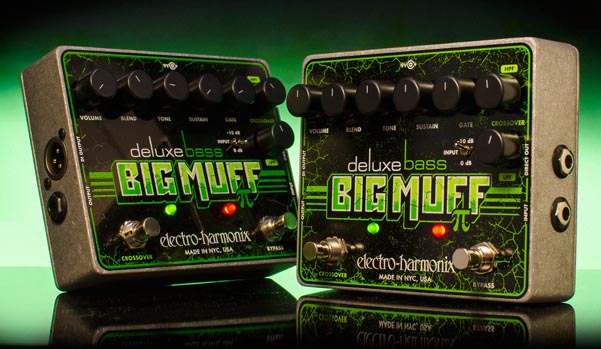
Shown above - The 2013 Deluxe Bass Big Muff Pi includes a normal out jack, buffered dry direct out jack, and an XLR di out jack.
ENCLOSURE AND GRAPHICS - The enclosure is 4.75 (h) x 5.75 (w) x 1.5-inch (d), cast metal two piece box with four screws on the bottom plate and four rubber pads. The DBBM graphics are in line with the trend of near full color graphic design used for most EHX enclosures at this time, featuring an edgy, textured green on black design. Same ITC Pioneer Big Muff font as used on previous Big Muffs.
CONTROLS / KNOBS - The new controls here are a separate dry mix pot, a noise gate, and a switchable crossover filter. There are two footswitches, one for the distortion circuit and one for the Crossover circuit.
- Classic VOLUME, TONE, and SUSTAIN control knobs, same as the Big Muff Pi classic, Little Big Muff, and Nano Big Muff
- INPUT - a toggle switch to select between 0dB (normal) or a-10dB input signal cut. The -10dB position was meant for guitars with active pickups (powered by a battery).
- BLEND - allows mixing the dry signal with the disortion signal. Alo works in conjunction with the Crossover circuit.
- CROSSOVER - a low pass filter knob (LPF) for the dry signal and a high pass filter knob (HPF) for the distortion signal. Works in conjunction with the Blend control
- GATE - a noise gate to eliminate high gain hiss noise or hum. This is more for power chords with hard starts/stops, or for staccato playing. Not for for playing where you want the notes or chords to naturally trail off or decay, as they will be cut off.
- BYPASS foot switch - engages distortion circuit, with true bypass
- CROSSOVER foot switch - engages Crossover circuit
- Three outputs: a 1/4 effect out, 1/4 direct (buffered dry) out and XLR DI out
CIRCUIT - The core circuit is based on the Bass Big Muff Pi (version 11). It is built with normal through-hole style transistors, capacitors, and diodes. Resistors are small surface mount style.
PACKAGING - 2-color corrugated cardboard box. "Your deep dish pi with everything" is printed on the inside box lid flap.
THE SOUND - The sound, although not identical to the original Bass Big Muff, is very similar. It is in the Sovtek tone family, in that it has a heavy, fat, but smooth disortion. Slightly less gain and less midrange scoop (meaning brighter mids) than the classic Big Muffs, Little Big Muff, and Nano Big Muff. Although it is called a Bass Big Muff, it is a normal Big Muff circuit as you would use for guitar. The bass specific features work very well with guitar or bass.
The Crossover circuit is the one unique feature on this version. With the CROSSOVER footswitch engaged a high pass filter (HPF) and low pass (LPF) filter is added to the circuit, basically like a wah filter. If you have ever left your wah in one position (cocked wah) to color the distortion from an amp or distortion pedal, that is what this is. You just kick the filter on or off with the footswitch, so you can use it as the rhythm sound with the BMP circuit, and kick it off for solos, or simply use the as a cocked-wah filer without the distortion circuit engaged.
There is a wide filter range with the HPF pot, but right at 12:00 is a nice cocked wah sound for guitar, especially with the neck pickup on a Strat. Flip the INPUT toggle switch to the -10db position and the sound clean up a bit and is less compressed. You can get some nice overdrive type tones in the 110dB position when using the HPF. Dial the sustain to max and the BLEND pot about 3:00 and it adds some nice smoothness to the BMP distortion. Switching on the HPF with the BLEND dialed down to around 9:00 gives some interesting low gain tones. Below the HPF pot is a low pass filter pot, LPF. It affects the dry signal using the BEND knob and adds some additional color to your tone. The GATE is used for reducing hiss noise when distortion circuit is engaged and you are not playing, but this circuit is relatively quiet already. The gate can also be used as an effect. Dial it up high and it cuts off the initial pick attack when playing staccato style (hard starts and stops) on bass or guitar. Dial the distortion down and you can get some sputtery gated effects on both guitar and bass, but it is very subtle.
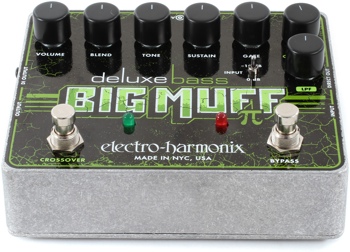
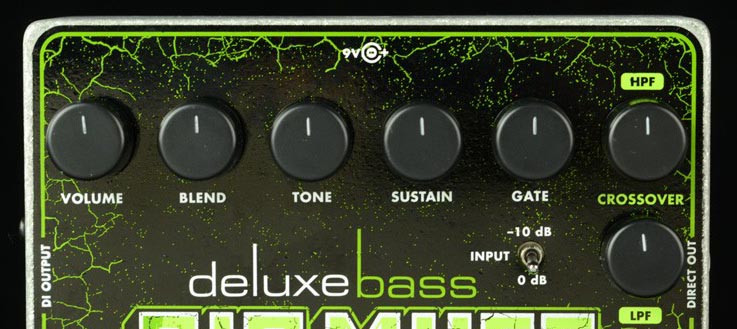
Shown above - Deluxe Bass Big Muff Pi control layout
CONTINUE - MORE OF THE HISTORY OF THE BIG MUFF PART 3 (Modern USA)
HISTORY OF THE BIG MUFF PART 1 (vintage USA)
HISTORY OF THE BIG MUFF PART 2 (Russian)
© Kit Rae. This page is not authorized, affiliated, or associated with Electro Harmonix in any way
Website and contents ©2007 and ©2010 Kit Rae. All rights reserved. Linking to this website is allowed, but copying the text content is strictly prohibited without prior authorization. No part of this work may be reproduced, stored in a retrieval system, or transmitted in any other form, or by any means, electronic, mechanical, photocopying, recording, computer networking, or otherwise without prior permission in writing from the copyright holder(s).
Kit’s Secret Guitar, Gear, and Music Page
Guitar stuff, gear stuff, soundclips, videos, Gilmour/Pink Floyd stuff, photos and other goodies.
Contact: nasnandos @ kitrae.net (remove spaces around @ to email)
Copyright Kit Rae.
VISIT MY SWORDS, KNIVES and FANTASY ART WEBSITE www.kitrae.net

